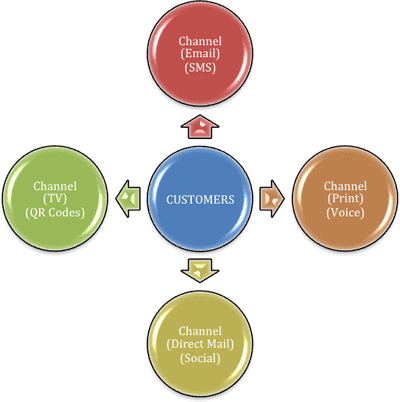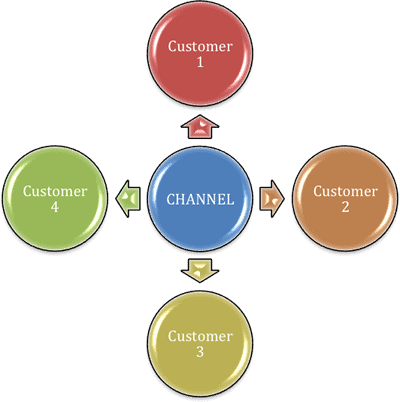We’ve touched on this topic before, but it’s comes up enough that it warrants discussing in greater detail. Here’s the argument, succinctly:
Mobile marketing is a database strategy, it is not a channel strategy.
So what does this mean exactly? Let’s take a look, Dr. Jack’s Breakdown style.
Centricity
In case nobody uses “centricity” in a mobile marketing context, (though GE would be proud), we’re using it to describe a strategy’s focal point or perspective. So in the same way that the earth and sun are focal points of a geocentric and heliocentric (respectively) universe, marketing strategies revolve around particular ideas or topics, ie we can describe their “centricity.”
Database: Customers are the centricity of a database marketing strategy. The goal of a database marketing strategy is to use various channels to improve how effectively you monetize your customers. Here’s a (crude) diagram:

As you can see, we have the theory (top line), an application for marketing in general (second line), and an application for mobile marketing (third line). Just as print media and TV can help a company achieve its goal of driving customer purchasing and activity, so can voice messaging and QR Codes.
Channel: Channel is the centricity of a channel strategy. In diagram form:

In this scenario, adding features and functionality to a particular channel is what allows you to interact with more and more customers, ie the focus of your strategy is monetizing a channel.
Advantage: What’s more important to you? Your customers or how you communicate with them? In my opinion, that’s like asking a multinational corporation whether it focuses on profits or the currency in which it earns those profits. Of course both are important, but the focal point should be customers and profits, not channels and currency.
SCORE: Database 1, Channel 0
Elevator Pitch:
The elevator test in two directions. On the way up a CEO hears about a new mobile channel called (I made this up) “Communicado” that his marketing director wants to integrate into a database strategy. On the way down he hears about Communicado from his channel marketing director. Which opinion is more convincing?
Database: We should integrate Communicado into our current marketing strategy as soon as possible. Right now customers in our core demographic open 99% of Communicado messages within 25 seconds of reading the message. This will increase the efficiency of our current messaging by 25%, which will have a 25% postive impact on our bottom line.
Channel: We should integrate Communicado into our current marketing strategy as soon as possible. Communicado is the most interactive channel on the market today, with an 89% open rate averaging 25 seconds after receipt. Compared to our current channels, which average a 60% open rate 40 seconds after receipt, we should see a 25% increase in efficiency and consequent 25% bump in profits.
Advantage: In case you missed it, the Database marketing strategy makes a logic connection that the Channel strategy disregards: the average open rates for a particular channel don’t matter nearly as much as the average open rates for the people that are actually going to be opening communication from a particular company. For example, let’s imagine a company that sells products to people in China. Should they get really excited that 35 hours of Youtube video gets uploaded every minute? Well, no. You’ll never hear a database marketer answer a “What channel is better” question without asking for the context first. Channel marketers, on the other hand, live for the “which channel is better” question and risk getting lost in unimportant details.
SCORE: Database 2, Channel 0
Degree of Difficulty
Plain and simple, what’s more difficult to implement?
Database: Putting your customer at the center of your strategy requires massive amounts of data coordination. You need to be able to track how customers interact with your brand, whether watching TV, using their phone, or accessing websites online.
Channel: For channel marketing, you need to optimize the experience for each of your customers across each channel. As long as the numbers for your channel look good, give yourself a pat on the back.
Advantage: Not much debate here (quiet down Robert Frost) – just ask the folks from our multinational corporation example whether they would prefer receiving all their profits in one or several currencies. Given we’re self-containing each category, focusing on cross-channel coordination is definitely more difficult than optimizing a single channel.
SCORE: Database 2 , Chanel 1.
Benefit to Other Channels
So you’ve got your strategy set up. But what’s the impact on the rest of the marketing channels?
Database: The goal of a database strategy is to learn about your customers so you can monetize those relationships most effectively. The benefit of this learning on other groups is that you can inform the direction of your other channels from a customer perspective. For example, customers providing you with positive feedback for your charitable giving efforts suggests that your TV campaign should highlight these efforts.
Channel: A channel strategy allows you to learn about the preferences of your channel customers. These channel-specific insights can help inform the strategic direction of your other channels. For example, a high click-through rate across online charitable giving campaigns suggests that you should roll out a similar campaign on, say, TV.
Advantage: Well we all know how that turned out. I obviously can’t be sure that Groupon had adopted a channel strategy, but I can be sure that a customer focused database strategy would have made it clear that helping people, not sarcasm, was what appealed to the company’s audience.
SCORE: Database 3, Channel 1.
Outcome
At this point, database strategy comes in as the clear winner. There’s more to explore here (which strategy adapts better to new channels like Android and iMessage; which strategy provides customers with the experience they want), but I’d be interested to hear your perspective. Please post any thoughts to the comments.


